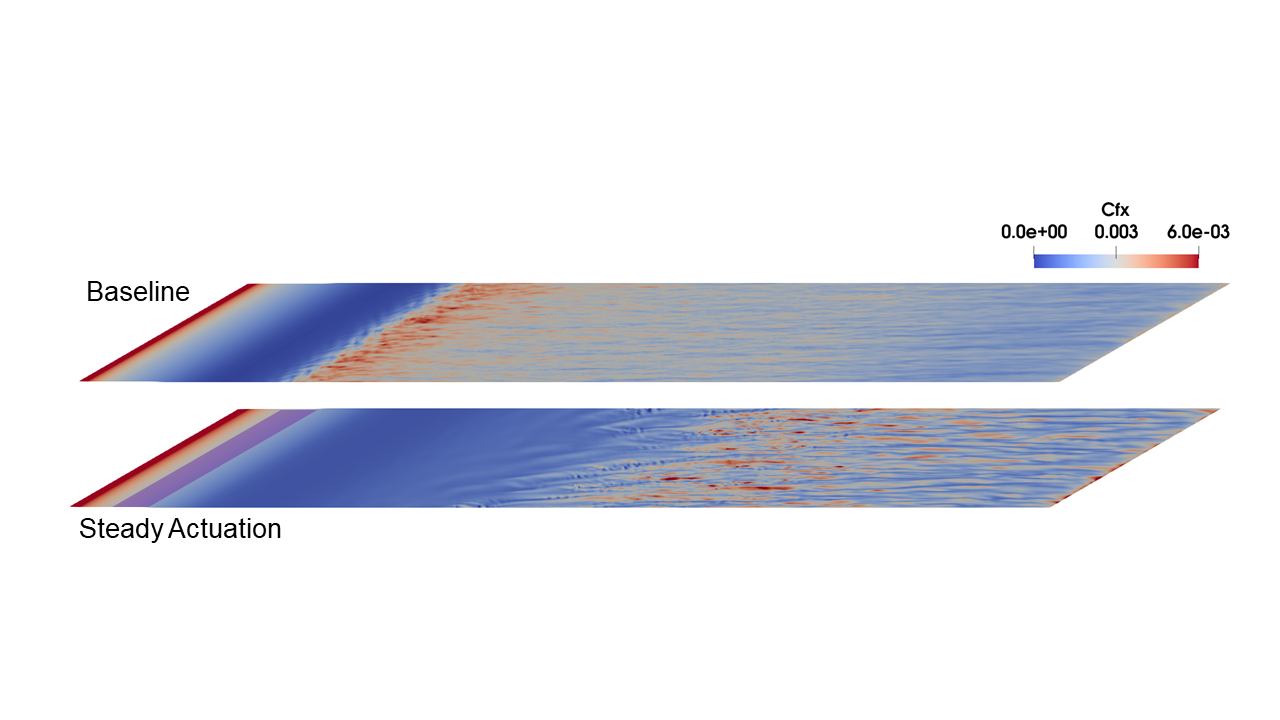Application of distributed micro plasma actuators
JAXA Supercomputer System Annual Report February 2021-January 2022
Report Number: R21EACA47
Subject Category: JSS Inter-University Research
- Responsible Representative: Takashi Matsuno, Associate Professor, Tottori University
- Contact Information: Takashi Matsuno(matsuno@tottori-u.ac.jp)
- Members: Yuki Fukushima, Toru Haraguchi, Takeo Hoshino, Masahiro Kanazaki, Yuki Kishi, Seiichiro Morizawa, Takashi Matsuno, Takumi Nankaku, Shintaro Okada, Teruchika Takano
Abstract
Plasma actuators (PAs) are flow control devices that use discharged plasma to generate wall jets from smooth surfaces. In recent years, a method of generating a distribution of body force on a surface by using a large number of small-scale PAs has been proposed by the applicants. The objective of this study is to obtain knowledge about the application method of plasma actuator and its optimization method for arbitrary control of the velocity profile of a three-dimensional boundary layer, keeping in mind the boundary layer control of high-speed flows.
Reference URL
N/A
Reasons and benefits of using JAXA Supercomputer System
In order to perform large-scale 3D flow analysis and aerodynamic optimization with high computational costs, a supercomputer is required. The JAXA supercomputer, which provides an environment for the use of computational tools, is the most suitable environment for this study.
Achievements of the Year
A research was conducted on the investigation of boundary layer flow control methods on swept wings, and the application of optimal design methods.
In the investigation of boundary layer flow control, a numerical analysis of the boundary layer was performed by RANS and LES for a flat plate wing models with sweptback angles. The analysis was done on the same conditions, the uniform flow velocity and the Reynolds number, of the wind tunnel tests being conducted at Tottori University. The JAXA-developed aerodynamic solver FaSTAR was used for the numerical calculations. The grids used in the LES analysis are 27 million points for the low-resolution case for a half-turned model, and 64 million points for the high-resolution case for an infinite swept wing model with a wingspan of 10% chord. The figure shows the skin friction distributions on the infinite swept wing for two cases: the base flow when U = 20 m/s, and when a body force source simulating a plasma actuator was applied to the boundary layer. When the body force was introduced perpendicular to the leading edge into the boundary layer, the location of the rapid increase in skin friction, which represents the turbulent transition location, was significantly delayed to the downstream. These results are in good agreement with the wind tunnel tests, confirming both the validity of the numerical analysis and the robustness of the control method.
For the optimal design method, a method to reduce the number of variables in multivariable optimization was proposed and applied to benchmark problems in order to minimize the increase in the number of cases, which is a bottleneck when using high-resolution and costly calculations. This has provided a foundation for the optimal design of the distributed body force sources. In the future research, we will consider to implement optimal design using LES, which was rerely feasible due to the computational cost, using the findings of this study.

Fig.1: Skin friction coefficient distribution on a swept wing: effect of transition delay by plasma actuators
Publications
- Oral Presentations
Yuto Miwa, Ikuya Yoshimi, Takashi Matsuno, Dongyoun Kwak, "Boundary-Layer Transition Control by Plasma Crossflow Reduction in Swept Wing", Asia-Pacific International Symposium on Aerospace Technology, 2021
Usage of JSS
Computational Information
- Process Parallelization Methods: MPI
- Thread Parallelization Methods: N/A
- Number of Processes: 48 - 9984
- Elapsed Time per Case: 10 Hour(s)
JSS3 Resources Used
Fraction of Usage in Total Resources*1(%): 0.20
Details
Please refer to System Configuration of JSS3 for the system configuration and major specifications of JSS3.
| System Name | CPU Resources Used(Core x Hours) | Fraction of Usage*2(%) |
|---|---|---|
| TOKI-SORA | 3768301.99 | 0.18 |
| TOKI-ST | 58581.19 | 0.07 |
| TOKI-GP | 0.00 | 0.00 |
| TOKI-XM | 0.00 | 0.00 |
| TOKI-LM | 77564.43 | 5.78 |
| TOKI-TST | 0.00 | 0.00 |
| TOKI-TGP | 0.00 | 0.00 |
| TOKI-TLM | 0.00 | 0.00 |
| File System Name | Storage Assigned(GiB) | Fraction of Usage*2(%) |
|---|---|---|
| /home | 357.50 | 0.36 |
| /data and /data2 | 19234.67 | 0.21 |
| /ssd | 716.67 | 0.19 |
| Archiver Name | Storage Used(TiB) | Fraction of Usage*2(%) |
|---|---|---|
| J-SPACE | 1.57 | 0.01 |
*1: Fraction of Usage in Total Resources: Weighted average of three resource types (Computing, File System, and Archiver).
*2: Fraction of Usage:Percentage of usage relative to each resource used in one year.
ISV Software Licenses Used
| ISV Software Licenses Used(Hours) | Fraction of Usage*2(%) | |
|---|---|---|
| ISV Software Licenses(Total) | 863.42 | 0.60 |
*2: Fraction of Usage:Percentage of usage relative to each resource used in one year.
JAXA Supercomputer System Annual Report February 2021-January 2022


